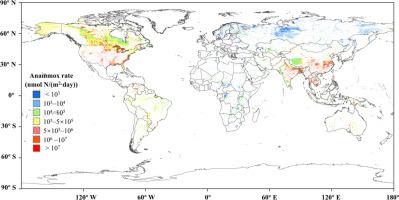全球湿地和氧最低带中厌氧氨氧化对活性氮损失贡献的量化
IF 6.3
2区 环境科学与生态学
Q1 ENVIRONMENTAL SCIENCES
引用次数: 0
摘要
厌氧氨氧化(anammox)通过抑制活性氮在全球氮循环中起着至关重要的作用。近年来,其生态重要性日益引起人们的重视。尽管其广泛存在,但厌氧氨氧化对全球氮损失的分布和定量贡献尚不清楚。利用15N同位素示踪技术收集了390份报告的厌氧氨氧化活性测量数据,并利用广义加性模型(GAMs)分析了厌氧氨氧化率与土壤/沉积物和水性质等环境因子的关系。此外,基于厌氧氨氧化活动区域的划分,我们估算了不同生态系统中厌氧氨氧化导致的氮损失,包括湿地和氧最小带(OMZs)生态系统。研究结果表明,土壤含水量是湿地生态系统厌氧氨氧化活性的最重要预测因子。水田占厌氧氨氧化氮损失的51% (32.0 Tg N/yr),其次是河流/湖泊(29%)和湿地(20%)。亚洲成为厌氧氨氧化导致氮损失的主要地区(30.7 Tg N/yr),其中稻田贡献很大。北美是第二大贡献者(25.4 Tg N/年),河流/湖泊是氮损失的主要来源。在OMZs生态系统中,硝酸盐和溶解氧是影响厌氧氨氧化速率的关键因素。omz是厌氧氨氧化的热点,在300 m深度处活性达到峰值,氮损失总计68.6 Tg N/yr,主要发生在100 ~ 500 m深度。该研究强调了厌氧氨氧化在全球氮循环中的关键作用,并通过厌氧氨氧化预测模型为环境氮管理提供了基础。本文章由计算机程序翻译,如有差异,请以英文原文为准。

Quantifying the contribution of reactive nitrogen loss through anaerobic ammonium oxidation in global wetlands and oxygen minimum zones
Anaerobic ammonium oxidation (anammox) plays a vital role in the global nitrogen cycle by mitigating reactive nitrogen. In recent years, its ecological importance has drawn increasing attention. Despite its widespread occurrence, the distribution and quantitative contribution of anammox to global nitrogen loss remain unclear. We collected 390 reported anammox activity measurements which were obtained using 15N isotope tracing techniques and analyzed anammox rate and environmental factors including soil/sediment and water property using generalized additive models (GAMs). Moreover, based on the division of the anammox activity region, we estimated anammox-driven nitrogen loss across different ecosystems including wetlands and oxygen minimum zones (OMZs) ecosystems. Our findings revealed that soil moisture content was the most significant predictor of anammox activity in wetlands ecosystems. Paddy fields contributed 51 % of anammox-driven nitrogen loss (32.0 Tg N/yr), followed by rivers/lakes (29 %) and wetlands (20 %). Asia emerged as the dominant region for anammox-driven nitrogen loss (30.7 Tg N/yr), with paddy fields making a substantial contribution. North America was the second-largest contributor (25.4 Tg N/yr), with rivers/lakes being the main sources of nitrogen loss. In OMZs ecosystems, nitrate and dissolved oxygen were key factors influencing anammox rates. OMZs were hotspots for anammox, with peak activity at 300 m depth and nitrogen loss totaling 68.6 Tg N/yr, mostly between 100 and 500 m depths. This study underscores the critical role of anammox in global nitrogen cycling and offers a basis for environmental nitrogen management through predictive anammox modeling.
求助全文
通过发布文献求助,成功后即可免费获取论文全文。
去求助
来源期刊

Journal of Environmental Sciences-china
环境科学-环境科学
CiteScore
13.70
自引率
0.00%
发文量
6354
审稿时长
2.6 months
期刊介绍:
The Journal of Environmental Sciences is an international journal started in 1989. The journal is devoted to publish original, peer-reviewed research papers on main aspects of environmental sciences, such as environmental chemistry, environmental biology, ecology, geosciences and environmental physics. Appropriate subjects include basic and applied research on atmospheric, terrestrial and aquatic environments, pollution control and abatement technology, conservation of natural resources, environmental health and toxicology. Announcements of international environmental science meetings and other recent information are also included.
 求助内容:
求助内容: 应助结果提醒方式:
应助结果提醒方式:


